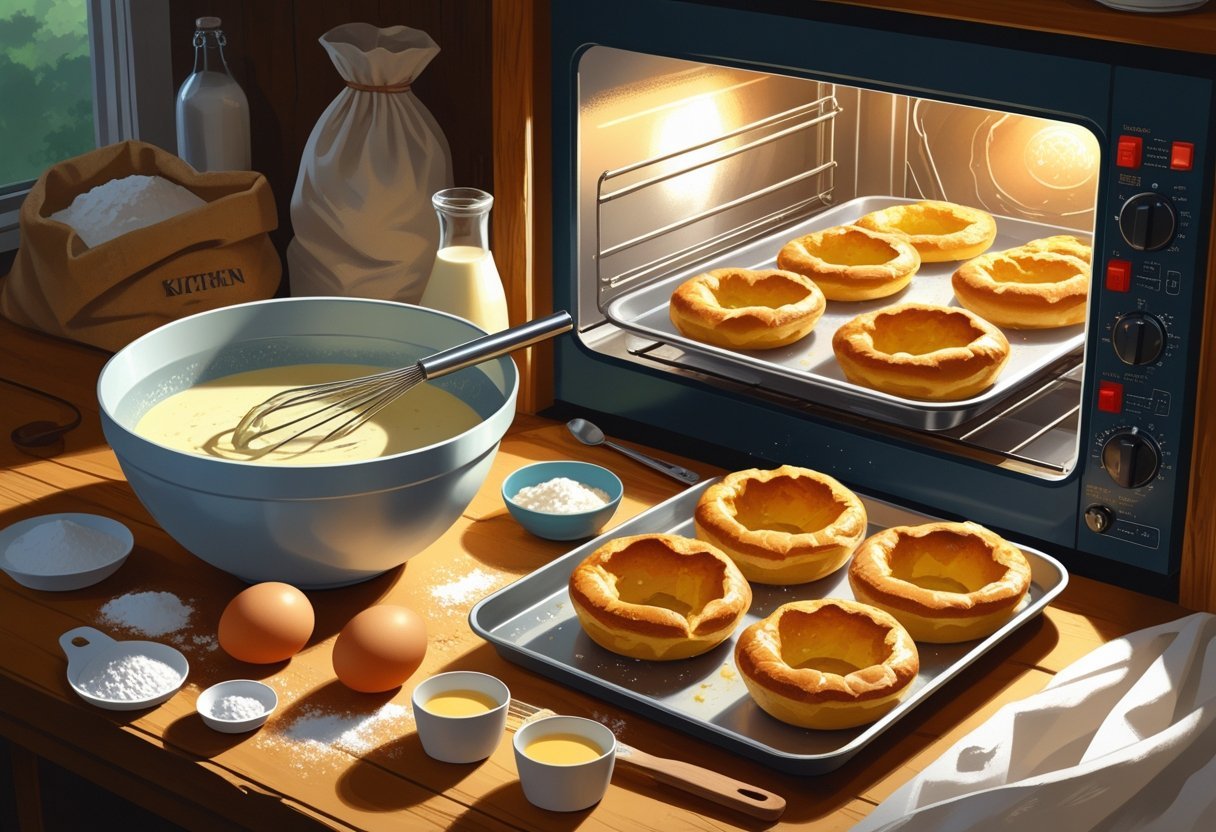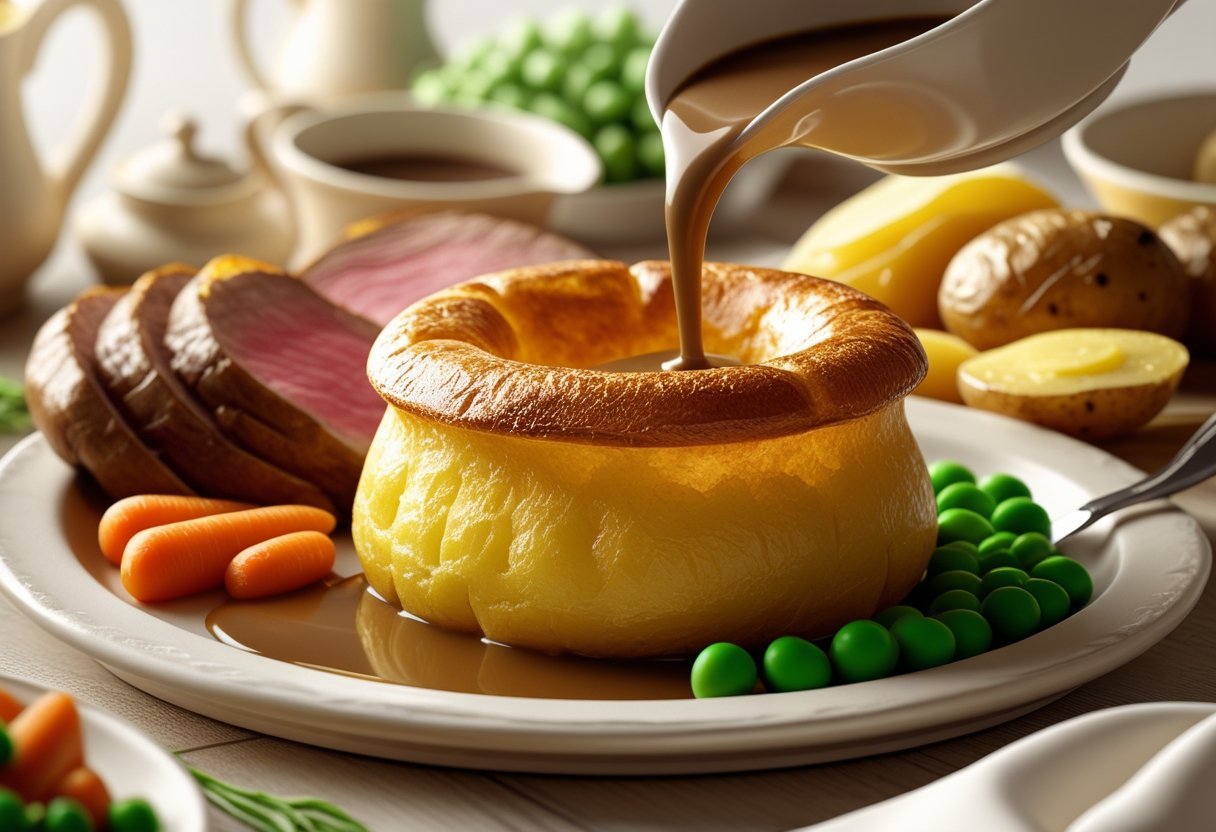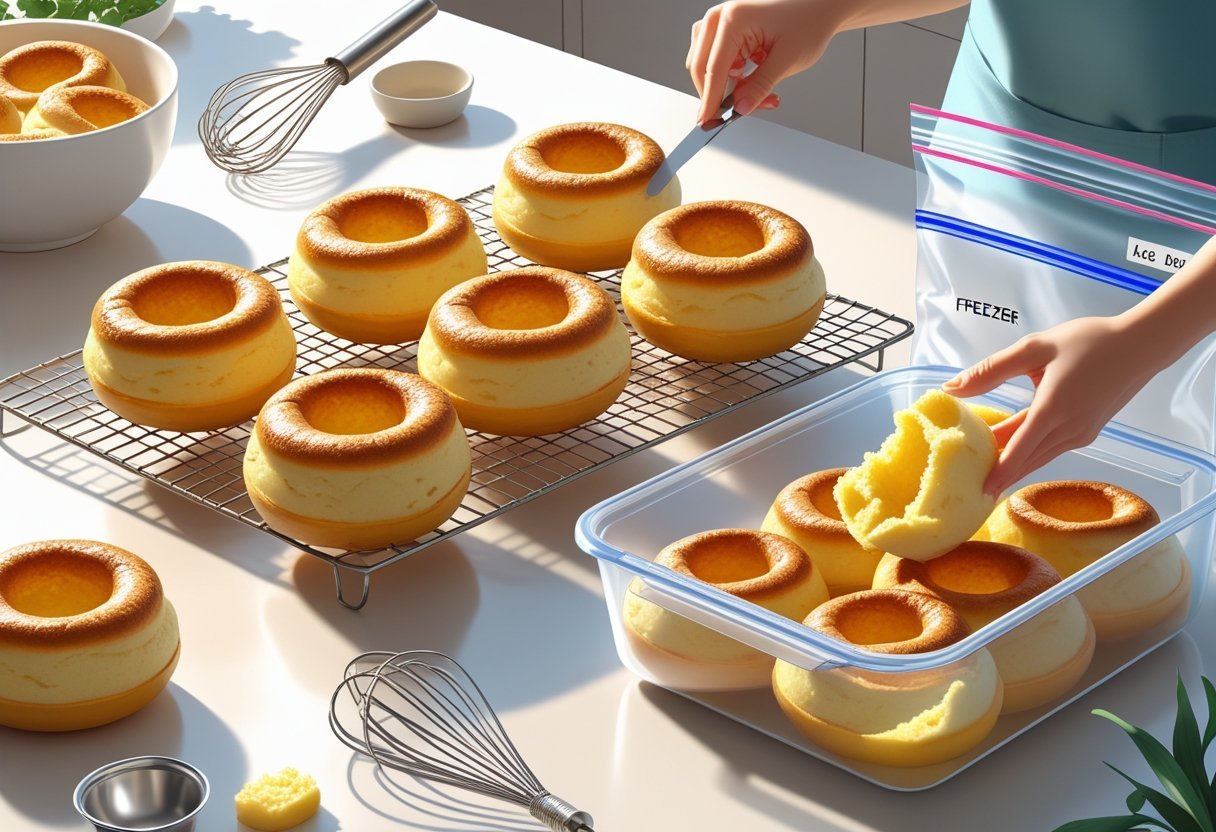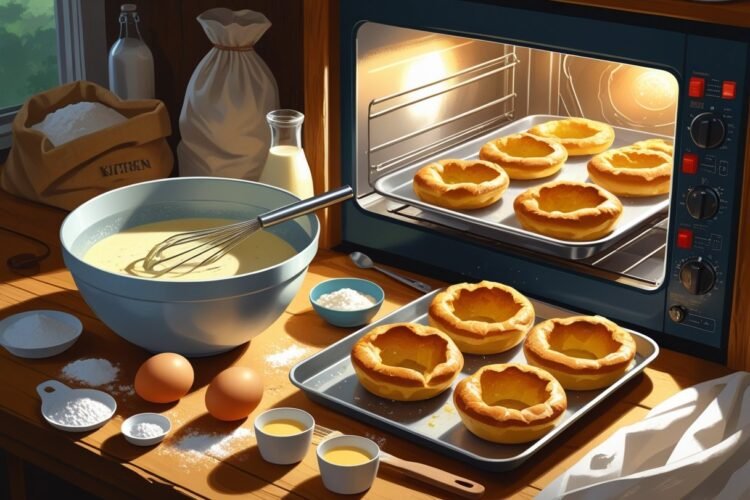Yorkshire pudding is a traditional British dish known for its light, crispy texture and golden puff. It is made from a simple batter of eggs, flour, and milk, baked in hot fat to achieve the iconic rise. The key to perfect Yorkshire pudding lies in using sizzling hot fat and avoiding opening the oven door during baking.

This versatile dish is most commonly served alongside roast beef, making it a staple for Sunday lunches and festive meals. Using beef drippings or vegetable shortening in the tin adds flavor and helps create the signature crisp edges. Yorkshire pudding combines straightforward ingredients with precise technique to deliver its unique texture.
Many chefs and home cooks value this dish for its simplicity and authenticity. Mastering the batter consistency and oven temperature ensures a reliable recipe for fluffy, crisp Yorkshire pudding every time.
What Is Yorkshire Pudding?
Yorkshire pudding is a savory baked dish known for its light, airy texture and crisp exterior. It plays a traditional role alongside roast beef in British cuisine and is made from a simple combination of ingredients cooked in hot fat or oil to achieve its characteristic rise.
Key Ingredients
The batter for Yorkshire pudding consists mainly of eggs, flour, and milk. Some recipes include water to adjust the consistency. A pinch of salt is often added to enhance flavor.
Eggs provide structure and leavening, while the flour creates a base that crisps when baked. Milk adds moisture and richness. The batter is thin, similar in texture to pancake mix, which allows the pudding to puff up dramatically when baked in hot fat.
Traditional Preparation Methods
Traditional Yorkshire puddings are baked in a very hot oven. The batter is poured into preheated pans greased with rendered fat from roast meat, typically beef drippings. This method helps create a crisp exterior and allows the pudding to rise effectively.
The high heat causes the liquid in the batter to steam, making the pudding puff. Timing is crucial; the pans must be piping hot before adding the batter to prevent sogginess. Yorkshire puddings are usually baked until golden brown and served immediately.
Yorkshire Pudding vs Popovers
Yorkshire puddings and popovers are similar but have key differences. Both use a batter of eggs, flour, and milk or water, and both puff up in hot ovens.
The main differences lie in size, shape, and preparation fat. Yorkshire puddings are generally served as part of a roast dinner and cooked in meat fat, which adds flavor. Popovers are often baked in greased muffin tins or specialized popover pans using butter or oil and are served as a breakfast or side dish.
The texture also varies slightly; Yorkshire puddings tend to be denser and crisper on the outside, while popovers are lighter and hollow inside.
How to Make the Perfect Yorkshire Pudding
The perfect Yorkshire pudding depends on several key factors: making a smooth batter, selecting the right cooking fat, thoroughly preheating both oven and tin, and mastering baking techniques that produce a crisp outside with a soft, airy inside. Each element plays a critical role in achieving the traditional rise and texture.
Preparing the Batter
A successful Yorkshire pudding batter starts with the right ratio of ingredients. Typically, 140g of plain flour, 4 large eggs, a pinch of salt, and 200ml of milk are used. Combining these ingredients gradually while whisking prevents lumps and creates a smooth, consistent batter.
Allowing the batter to rest for at least 30 minutes is essential. This rest period improves gluten development and results in a better rise during baking. Some recipes suggest adding a splash of water to lighten the batter, but using milk alone often gives the preferred creaminess.
Whisk the batter just before pouring it into the hot fat to ensure it stays aerated. Avoid overmixing, which can cause a dense texture. Pour the batter from a jug for control and even distribution.
Choosing the Right Fat
The choice of fat affects both flavor and texture. Beef drippings, pan drippings, or beef fat are traditional choices, offering authentic taste and excellent heat retention. However, vegetable oil is a reliable alternative and reaches the necessary high temperature quickly.
Use about one teaspoon of fat per pudding compartment in a muffin tin. The fat must be heated until it is nearly smoking hot before adding the batter; this helps create steam, causing the pudding to rise sharply.
Avoid using butter or fats that burn easily, as they can impart a burnt flavor and hinder the rise. Consistent high heat in the fat is crucial to forming the crispy exterior.
Preheating the Oven and Tin
Preheating is critical. The oven should reach 400 degrees Fahrenheit (200 degrees Celsius) before the batter is added. Place the muffin tin, filled with fat, into the oven and heat for at least 10 minutes until the fat is extremely hot.
A preheated tin ensures that the batter sizzles on contact with the fat, which is vital for creating steam. This steam inflates the pudding, producing the characteristic puffed shape.
Do not open the oven door during cooking, as this causes temperature fluctuations and can cause the puddings to collapse. Use a heavy-duty oven thermometer if available to confirm consistent heat.
Baking Techniques
Pour the batter evenly into the hot fat-filled compartments immediately after removing the tin from the oven. The batter should bubble on contact with the fat.
Bake for 20 to 25 minutes without opening the oven door. The puddings will puff up, turning golden brown and crisp on the outside while remaining soft inside.
For best results, use a muffin tin or a dedicated Yorkshire pudding tray. These provide individual compartments that promote even cooking and consistent shapes.
If a recipe tip calls for using a blast of heat at the start or switching the oven mode to convection, follow those instructions carefully to enhance the rise and texture. Cooling puddings slightly out of the oven will let them set without collapsing.
Tips for Success
Making Yorkshire pudding requires attention to detail at every stage, especially with the batter and oven temperature. Proper preparation and timing are critical for achieving the signature rise and texture.
Batter Resting Time
Allowing the Yorkshire pudding batter to rest is essential. After mixing, the batter should sit for at least 30 minutes at room temperature. This resting period lets the flour fully absorb the liquid, creating a smoother, lighter batter.
Resting also helps the gluten relax, which improves the texture and prevents toughness. Some recipes recommend resting the batter up to an hour, but half an hour is usually sufficient for good results.
Before pouring into the muffin tin, give the batter a gentle stir, but avoid overmixing after resting. This helps maintain the batter’s airiness, which is important for rise.
Preventing Deflation
To prevent Yorkshire puddings from deflating quickly, the oven and fat must be properly heated. The oven should be preheated to around 400 degrees Fahrenheit to ensure rapid puffing.
Use a muffin tin or individual pudding molds placed in the hot oven with a small amount of hot fat—such as beef drippings or vegetable oil—in each cup. The batter hits the hot fat and begins to rise immediately.
Avoid opening the oven door during cooking, as temperature drops can cause puddings to collapse. After baking, let them sit briefly out of the oven before serving to stabilize.
Secret to the Best Rise
The key to a good rise is combining a hot oven, properly heated fat, and a well-prepared batter. The batter’s fluid consistency must be smooth but slightly thick, similar to heavy cream.
Pouring cold batter into hot fat creates steam, which puffs up the batter quickly. High oven temperature (around 400°F) supports this process.
Additionally, using equal parts of eggs, flour, and milk by volume helps maintain balance in the Yorkshire pudding batter. This simple ratio ensures consistent texture and lift.
Ensuring the fat is smoking hot before adding the batter is crucial. If it’s not hot enough, the batter will absorb the fat rather than puffing up, resulting in soggy, flat puddings.
Serving Suggestions

Yorkshire pudding pairs well with rich, savory dishes and offers versatility beyond traditional meals. It complements hearty meats and vegetables, and can be served either as a side or a vessel for fillings. The following ideas show how to enhance the dining experience using this classic British dish.
With Roast Beef
Roast beef and Yorkshire pudding form a traditional British pairing, particularly in a Sunday roast. The pudding’s light, fluffy texture contrasts well with the dense, tender slices of beef.
Beef gravy or thick onion gravy poured over the pudding adds moisture and depth. The pudding absorbs these sauces, making each bite flavorful. This combination highlights the balance of textures and intensifies the rich beef flavor.
Roast beef served with Yorkshire puddings remains a staple at many British tables, especially during family gatherings and holidays like Christmas.
Sunday Roast Pairings
Yorkshire pudding is a central element of a Sunday roast, which typically includes roasted pork, lamb, or chicken alongside root vegetables such as carrots, parsnips, and potatoes.
Accompanying the pudding with thick beef or chicken gravy enhances the meal’s cohesion. Vegetables roasted to caramelized perfection provide contrasting texture and sweetness.
Additional sides like peas, cabbage, or Brussels sprouts complete the plate. These complement the savory pudding and roast, creating a balanced, hearty meal ideal for Sunday afternoons.
Creative Serving Ideas
Beyond traditional uses, Yorkshire puddings can serve as edible containers for stews or fillings. For example, large puddings made on dinner plates work well as vessels for rich Irish stew or mushrooms in sauce.
They can be filled with savory mixtures like sausage and apple sauce for a bite-sized appetizer or main dish twist. Serving smaller puddings alongside dips or chutneys offers a modern take.
Sweet variations are also possible, where fillings like berries or custards turn Yorkshire pudding into a dessert, demonstrating its versatility beyond its British roast roots.
Storage and Freezing

Yorkshire pudding requires careful storage to maintain its crisp texture and flavor. Proper refrigeration can keep it fresh for a short time, while freezing extends its shelf life without major loss in quality. Knowing the best ways to freeze and reheat Yorkshire pudding ensures it remains enjoyable when served later.
Refrigeration Guidelines
Yorkshire pudding should be cooled completely before refrigeration to prevent sogginess. Once cooled, place the puddings in an airtight container or wrap them tightly with foil or plastic wrap.
Refrigerate at or below 40°F (4°C) for up to two days. Longer storage in the fridge risks the pudding becoming soggy and losing its crisp texture. Avoid stacking them as this can make the bottoms damp.
If refrigerated, reheat quickly in a hot oven to restore some of the original crispness.
How to Freeze Yorkshire Pudding
Freezing Yorkshire pudding extends its freshness for up to three months. First, arrange the cooked puddings in a single layer on a baking sheet. Freeze them uncovered until solid to prevent clumping.
Once frozen, transfer the puddings to a freezer-safe bag or airtight container. Remove as much air as possible to prevent freezer burn.
If freezing batter instead, portion it in muffin tins and freeze before baking. This method allows fresh baking straight from the freezer.
Reheating Instructions
Preheat the oven to 400 degrees F (200 degrees C) for best results. Reheat frozen Yorkshire puddings directly from the freezer without thawing.
Place them on a baking sheet and heat for 8 to 10 minutes. This restores crispness while warming the interior evenly.
Avoid microwaving as it can make the pudding soggy and rubbery. Reheating this way keeps the texture close to freshly baked Yorkshire pudding.
Troubleshooting Common Issues
Yorkshire puddings require precise conditions to achieve the ideal texture and rise. Key factors include oven temperature, batter consistency, and cooking vessels. Adjustments to these elements can resolve common problems.
Flat or Soggy Puddings
Flat or soggy Yorkshire puddings usually result from insufficient oven heat or undercooking. The oven must be fully preheated to a high temperature, typically around 220°C (425°F), to create the necessary steam for rising.
If the batter is too thin or overmixed, it can lose structure. The right balance of eggs, flour, and liquid is critical. Avoid opening the oven door during cooking, as this causes heat loss, leading to flat results.
Cooking time should be long enough to form a crisp, golden exterior. Undercooking leaves the center soggy. Using a well-heated, oiled baking tray or muffin tin helps achieve proper texture.
Uneven Rising
Uneven rising often occurs due to inconsistent oven heat or uneven batter distribution. Hot spots in the oven can cause some puddings to rise while others remain flat.
Ensure the oven temperature is stable and the rack is centered. The batter should be poured evenly into the pan so each Yorkshire pudding gets the same amount of batter.
Overcrowding the pan restricts hot air circulation. Use fewer Yorkshire puddings per batch if needed, allowing space between them. Batter temperature also affects rise—room temperature batter performs best.
Alternative Pan Choices
While traditional metal roasting tins or muffin tins work best, some use alternative pans. The material and size of the pan influence heat retention and distribution.
Metal pans heat quickly and evenly, essential for the sharp temperature rise Yorkshire puddings require. Glass or ceramic pans heat slower, risking underperformance in rising.
If alternative pans are used, increase oven temperature slightly and extend cooking time. Choose pans with deeper compartments to accommodate batter expansion. Always preheat the pan with oil to smoking point before adding batter to ensure a strong initial rise.
